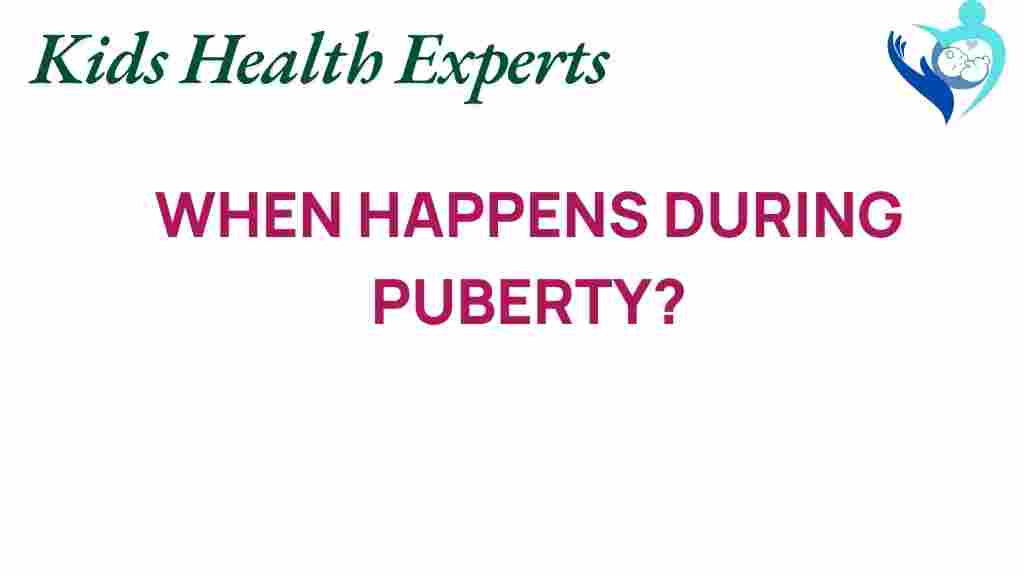Unveiling the Mysteries: What Happens During Puberty?
Puberty marks a pivotal stage in human development, signifying the transition from childhood to adolescence. This period is characterized by a series of profound changes, both physical and psychological, that shape an individual’s identity and health. Understanding what happens during puberty is crucial for parents, educators, and adolescents themselves. This article will explore the various aspects of puberty, including hormonal changes, growth patterns, and the psychological impacts of this developmental phase.
Understanding Puberty
Puberty typically occurs between the ages of 9 and 14 for girls and 10 to 15 for boys, although the timing can vary widely. This period is initiated by hormonal signals from the brain that stimulate the reproductive organs, leading to a cascade of changes throughout the body. Here are some key points to understand about puberty:
- Hormonal Changes: The onset of puberty is driven by hormones, primarily testosterone in boys and estrogen in girls.
- Physical Development: Children experience rapid growth, including changes in body shape and size.
- Psychological Effects: Adolescents may experience emotional turbulence due to hormonal fluctuations.
- Social Changes: As adolescents develop, their social interactions and relationships begin to evolve.
The Role of Hormones in Puberty
Hormones play a critical role during puberty, acting as messengers that facilitate various bodily changes. Here’s how hormones influence development:
- Testosterone: In boys, testosterone is responsible for the development of secondary sexual characteristics such as facial hair, a deeper voice, and increased muscle mass.
- Estrogen: In girls, estrogen leads to breast development and the regulation of the menstrual cycle.
- Growth Hormone: Released from the pituitary gland, this hormone contributes to the growth spurts commonly seen in both boys and girls during puberty.
Physical Changes During Puberty
As adolescents move through puberty, they undergo several significant physical changes:
- Growth Spurts: Most adolescents experience a rapid increase in height and weight, often leading to a temporary phase of awkwardness.
- Body Composition: Changes in body fat distribution occur, with boys generally gaining muscle mass and girls developing more body fat.
- Skin Changes: Hormonal fluctuations can lead to increased oil production, resulting in acne and other skin issues.
- Menstruation: For girls, the onset of menstruation is a significant milestone that marks reproductive capability.
Psychological Changes During Adolescence
Puberty is not just a time of physical transformation; it also brings about significant psychological changes:
- Emotional Variability: Adolescents may experience mood swings and heightened emotions due to hormonal changes.
- Identity Formation: This is a critical time for self-discovery, where adolescents begin to explore their identities and values.
- Peer Relationships: Friendships become more important, and social dynamics can shift dramatically.
- Independence: Adolescents often seek more autonomy from their parents, leading to potential conflicts.
The Importance of Education and Communication
Educating adolescents about puberty is essential for their development and health. Open communication can alleviate fears and misconceptions about the changes they are experiencing. Here are some strategies for effective education:
- Provide Accurate Information: Use age-appropriate language and materials to explain the physiological and psychological changes during puberty.
- Encourage Questions: Create an open environment where adolescents feel comfortable asking questions about puberty and related topics.
- Discuss Health and Hygiene: Teach adolescents about the importance of personal hygiene and self-care during this transitional phase.
- Talk About Emotions: Acknowledge that emotional changes are normal and encourage discussions about feelings and mental health.
Health Considerations During Puberty
During puberty, maintaining good health is paramount. Here are some health considerations for adolescents:
- Nutrition: A balanced diet rich in vitamins and minerals supports growth and development. Focus on:
- Fruits and vegetables for essential nutrients.
- Whole grains for energy.
- Protein sources for muscle development.
- Physical Activity: Regular exercise is important for physical health and can help manage stress and emotional fluctuations.
- Sleep: Adolescents need adequate sleep for growth and cognitive function, aiming for 8-10 hours per night.
- Regular Check-ups: Routine medical visits can help monitor physical and emotional health during this critical phase.
Common Challenges During Puberty
While puberty is a natural process, it can come with its own set of challenges. Here are some common issues that may arise:
- Body Image Concerns: Many adolescents struggle with body image issues as they compare themselves to peers and media representations.
- Peer Pressure: The desire to fit in can lead to risky behaviors, including substance use and unhealthy relationships.
- Academic Stress: Balancing schoolwork and social life can be challenging and lead to anxiety and stress.
- Mental Health Issues: Some adolescents may face depression or anxiety during puberty, making access to support essential.
Troubleshooting Tips for Parents and Educators
To support adolescents through puberty, it’s important for parents and educators to be proactive. Here are some troubleshooting tips:
- Be Present: Show interest in their lives and be available for discussions about their experiences and feelings.
- Encourage Healthy Relationships: Guide adolescents in building positive friendships and navigating social dynamics.
- Promote Open Dialogue: Keep lines of communication open regarding health, emotions, and any challenges they face.
- Seek Professional Help: If an adolescent is struggling significantly, don’t hesitate to seek support from a mental health professional.
Conclusion
Puberty is a transformative period filled with growth, change, and exploration. Understanding the nuances of this process can empower both adolescents and their caregivers to navigate this complex phase. By fostering open communication, providing education, and supporting health, we can help young people embrace their development with confidence. Remember, while puberty can be challenging, it is also a time of exciting growth and self-discovery.
For more information on adolescent health and development, check out this resource. And for a deeper dive into the psychological aspects of adolescence, visit this article.
This article is in the category Growth and created by KidsHealthExperts Team
